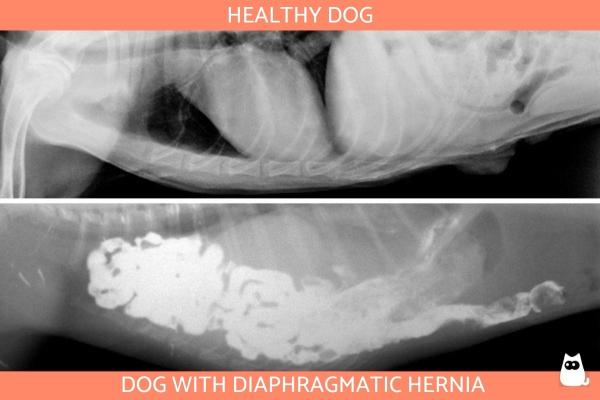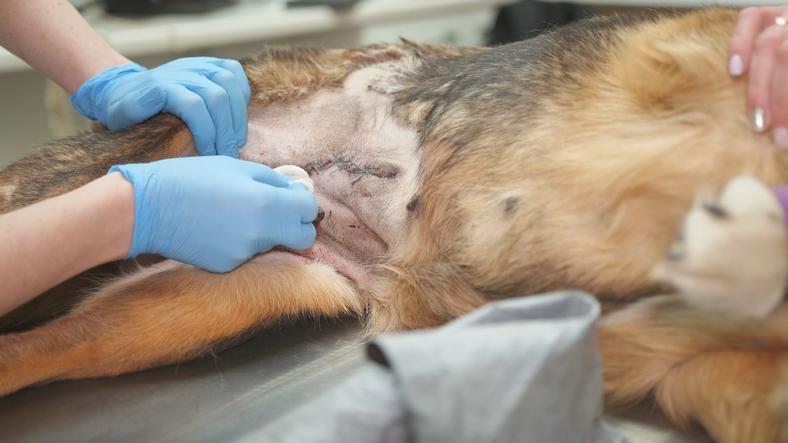Diaphragmatic Hernia in Dogs and Puppies



See files for Dogs
A diaphragmatic hernia can occur when a dog has suffered a traumatic event such as being in a road collision or fall. When the trauma is strong enough to cause a defect in the diaphragm, it allows abdominal viscera to pass into the chest cavity. However, there is also a congenital link to diaphragmatic disorders. In these cases, the puppy is born with the hernia and, although it sometimes takes time for the hernia to become apparent, it will need to be resolved as soon as possible.
Keep reading this article from AnimalWised to know all about diaphragmatic hernias in dogs and puppies. We share their causes, symptoms and treatment options so you can known what to expect if your canine experiences this problem.
What is a diaphragmatic hernia?
A diaphragmatic hernia is one which occurs in the diaphragm of dogs. The diaphragm is the muscular structure that separates the abdominal and thoracic cavities and their organs, at the same time playing an important function in the animal's respiration. The hernia is the abnormal emergence of tissue through an opening which shouldn't be there, in this case the passage of abdominal organs into the thoracic cavity.
There are two types of diaphragmatic hernia in dogs: congenital and traumatic.
Congenital diaphragmatic hernia
Dogs are born with a hernia when there has been inadequate or defective development of the diaphragm during embryonic development. These types of canine hernia can be subdivided further into:
- Peritoneopericardial hernia: when abdominal tissues penetrate the pericardial sac of the heart.
- Pleuroperitoneal hernia: when abdominal tissues enter the pleural space of the lung.
- Hiatal hernia: when the distal esophagus and part of the stomach pass through the esophageal hiatus of the diaphragm and enter the thoracic cavity.
Traumatic diaphragmatic hernia
Such hernias occur when a traumatic external process, such as traffic collision, a fall from a great height or being crushed, causes a tear in the diaphragm.
The severity of the condition will vary according to the severity of the damage and the rupture in the diaphragm. More severe damage allowing the passage of more abdominal contents and increased hindering of the dog's vital functions, including their ability to breathe.
Symptoms of diaphragmatic hernia in dogs
The clinical signs presented by a dog with diaphragmatic hernia are mostly respiratory. This is due to the compression exerted by the abdominal viscera on the lungs, hindering their ability to breathe correctly. It’s worth remembering that congenital hernias may not become evident, due to less acute and intermittent symptoms, until the dog reaches a certain age. Acute cases include traumatic hernias, where the dog usually shows tachycardia, tachypnea, cyanosis (bluish coloration of the mucous membranes) and oliguria (decreased urine output).
The main symptoms of a dog with a diaphragmatic hernia are:
- Dyspnea or respiratory distress
- Anaphylactic shock
- Dysfunction of the chest wall
- Air in the thoracic cavity
- Reduction in lung distension
- Pulmonary edema
- Dysfunction of the cardiovascular system
- Cardiac arrhythmias
- Tachypnea (abnormally rapid breathing)
- Muffled breathing sounds
- Lethargy
- Thoracic borborygmi (gurgling noises)
- More pronounced heartbeat on one side of the thorax
- Fluid or viscera in the pleural space
- Palpitation of the abdomen
- Vomiting
- Gastric dilatation
- Oliguria
Diagnosis of diaphragmatic hernia in dogs
The first thing carried out in the diagnosis of a diaphragmatic hernia is to perform an x-ray, especially of the chest, in order to assess the damage. In 97% of dogs, an incomplete silhouette of the diaphragm is observed and in 61% of dogs, gas-filled bowel loops are found in the thoracic cavity. Observation will show abdominal contents in the pleural space, which could be a hydrothorax due to pleural effusion, in recent cases, or a hemothorax with hemorrhage in more chronic cases.
To assess respiratory capacity, analysis of arterial blood gas and non-invasive pulse oximetry are used to determine ventilation-perfusion inequality and the alveolar-arterial oxygen gradient. Likewise, an ultrasound can identify abdominal structures in the thoracic cavity and can sometimes even determine the location of the diaphragmatic defect.
To confirm the presence or absence of a hernia in dogs, contrast techniques are used. These include barium administration, pneumoperitoneography and positive contrast peritoneography using iodinated contrast. This is only used for dogs that can tolerate it and if imaging tests have not been conclusive.
The gold standard for the diagnosis of diaphragmatic hernia in dogs is computed tomography, but it is not often an option due to its high cost.

Treatment of diaphragmatic hernias in dogs
Correction of diaphragmatic hernia in dogs is achieved by surgery. About 15% of dogs die before surgery, with pre-surgery treatment for the shock being the key to survival. Those that are operated on immediately, i.e. within the first day of the trauma, have a high mortality rate of around 33%. If their cardiorespiratory state permits, it is better to wait a little longer until the animal is stabilized and the risk of anesthesia complications is reduced.
What does diaphragmatic hernia surgery in dogs consist of?
The surgical operation to resolve hernia consists of a celiotomy or ventral midline incision to be able to see inside the abdominal cavity and access the entire diaphragm. Subsequently, the constricted viscera in the thoracic cavity must be freed in order to restore their blood supply as soon as possible. Herniated viscera should also be repositioned in the abdominal cavity. Occasionally, if circulation has been very badly affected, the necrotic portion must be removed. Finally, the diaphragm and skin opening is closed in layers.
Drugs, such as opioids, should be prescribed after the surgery to treat the pain, and the dog should be kept in a safe, quiet place, and be well fed and hydrated.
Prognosis of diaphragmatic hernia in dogs
Death from diaphragmatic hernia is due to hypoventilation, resulting from the compression of the lungs by the viscera, the shock, arrhythmias and multi-organ failure. However, most dogs that undergo diaphragm reconstruction survive and manage to fully recover their quality of life.
Diaphragmatic hernias are not the only type of this condition which can affect dogs. Take a look at our articles on perineal hernias in dogs and inguinal hernias in dogs to know more.
This article is purely informative. AnimalWised does not have the authority to prescribe any veterinary treatment or create a diagnosis. We invite you to take your pet to the veterinarian if they are suffering from any condition or pain.
If you want to read similar articles to Diaphragmatic Hernia in Dogs and Puppies, we recommend you visit our Other health problems category.
- VE Chamizo, FM Barcia. Diaphragmatic hernias. Available at: http://www.uco.es/organiza/departamentos/anatomia-y-anat-patologica/peques/curso01_05/HerniaDiafrag.pdf
- Axon Veterinary. Diaphragmatic hernia . Available at: http://axonveterinaria.net/web_axoncomunicacion/auxiliarveterinario/40/AV_40_Hernia_diafragmatica.pdf
- American College of Veterinary Surgeons. Diaphragmatic hernia . Available at: https://www.acvs.org/small-animal-es/diaphragmatic-hernia






